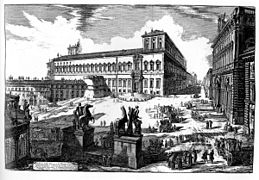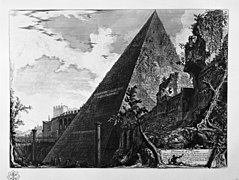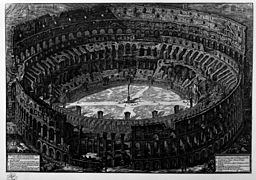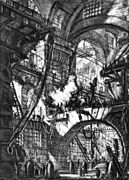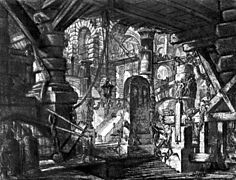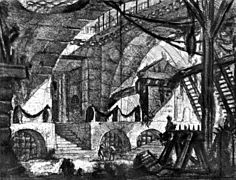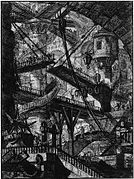Giovanni Battista Piranesi
Giovanni Battista Piranesi [dʒoˈvanːi baˈtːista piraˈneːzi] (Mogliano Veneto, near from Treviso, October 4, 1720 – Rome, November 9, 1778) was an Italian archaeologist, architect, researcher and engraver. He made more than 2,000 engravings of real and imagined buildings, statues and reliefs from Roman times, as well as original designs for fireplaces and furniture.
Biography
Piranesi was born in Mogliano Veneto, which then belonged to the Republic of Venice. He studied Architecture in Venice with his maternal uncle Matteo Lucchesi, who was Magistrato delle Acque in the city. There he discovered the works of Palladio, Vitruvio and some ancient buildings. Piranesi barely became an architect (only one of his designs was erected), although his studies allowed him to draw more easily, and he showed off his training by signing some engravings as Piranesi architetto .
He moved to Rome in 1740, together with Marco Foscarini, envoy of the Pope in Venice. The ruins of the Roman Empire ignited his enthusiasm and the need to represent them. At that time, archeology was not yet a very rigorous science, and in many cases it was about simple looting. Combining descriptive eagerness and fantasy, Piranesi recorded the Roman ruins and the discoveries that were being produced.
He met the scholar G. G. Bottari in Rome and learned the technique of etching with Giuseppe Vasi, with whom he signed some images. His first engravings were views of the city, intended for illustrated guides. In 1743 he published the first major series of prints by him, Prima Parte di Architettura e Prospettiva. Made at just 23 years old, he already reveals his mastery as an engraver and his inventiveness.
He opened his workshop in front of the French Academy in Rome, which made him live in constant contact with the scholars of that country. He was very successful with his prints as most visitors to Rome liked to return with a souvenir, and his prints were printed in large print runs which made them very affordable.
In 1761 he became a member of the Academia di San Luca. He died in 1778 and was buried in the only church he built: Santa María del Priorato.
Work
His enthusiastic reproductions and interpretations of ancient Roman monuments made an important contribution to the formation and development of Neoclassicism. These engravings included reliable and exact images of the existing ruins, as well as imaginary reproductions of old buildings in which the alteration of the scale and the juxtaposition of elements contribute to enhance their grandiose character.
One of Piranesi's earliest and most renowned collections of engravings were his Prisons (Carceri d'Invenzione, 1745-1760), in which he transformed Roman ruins into fantastically oversized dungeons dominated by huge and dark passageways, steep stairs to incredible heights and strange galleries that lead to nowhere. These engravings exerted an enormous influence on Romanticism in the 19th century, also playing a prominent role in the development, as early as the 19th century. XX, surrealism and even in the sets for horror movies.
He was also extremely famous for his magnum opus Le Antichità Romane: more than 200 engravings in four volumes, published in 1756. It includes views of the ruins of funerary monuments in and around Rome as well as detailed illustrations of Roman town planning, even the way the streets were paved. To create this work, Piranesi personally explored almost all the sites and ruins, rigorously taking measurements and notes to make very precise engravings. It was a titanic task that required ten years of work.
Piranesi's engravings, many of them large-format and arranged in books, were quickly exported to England and other countries, as souvenirs of the Grand Tour, the forerunner of modern cultural tourism. Those sheets influenced palace architecture, especially English country houses.
Many plates by the artist continued to be printed into the early 19th century in Paris; They were first exploited by his son Francesco Piranesi and on his death they passed to the workshop of Firmín Didot. In 1839 these copper matrices were acquired by emissaries of Pope Gregory XVI for the Calcografia Camerale founded by Clement XII, predecessor of the current Calcografia Nazionale of Rome, dependent on the Istituto Nazionale per la Grafica, where they are still preserved.
Prints by Piranesi exist in almost every ancient library in Europe. In Spain, the collections of the National Library stand out: more than 2000 prints, both loose and in bound volumes, which have been the subject of an exhibition in 2019 [1]. The Museum of Fine Arts of Valencia also has a rich repertoire: some 880 prints, almost all of them acquired in the same century XVIII.
Even today the engravings of this artist are in high demand and valued, partly because they continue to be framed and used as a decorative element in interiors of all styles.
His main works as an engraver and theorist were:
- 1743: Prima parte di Architettura e Prospettive
- 1756: Capricci Decorative Romane
- Le Vedute di Roma
- Le Antichità Romane
- 1757: Colosseum view
- 1761: Rovine dell castello dell'Acqua Giulia
- Lapides Capitolini and il Campo Marcio dell'antica Rome
- 1763: Descrizione dell'emissario del Lago Albano
- 1764: Antichitá di Cora
- 1765: Stop sull'Architettura
- 1769: Diverse Maniere d'adornare i camini
- Ragionamento apologetico in difesa dell'architettura egiziana e toscana
- Della Magnificenza ed Architettura de Romani
Prianesi only saw one of his architectural designs built: the church of Santa Maria del Priorato in Rome, seat of the Knights of the Order of Malta, as well as the square that gives access from the Aventine.
Gallery
Views of Rome
Roman Antiquity
Le Carceri d'Invenzione
Contenido relacionado
Henri de Toulouse-Lautrec
Vincent fox
Peter Salinas


